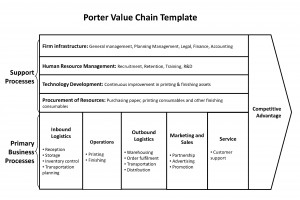VALUE CHAIN MODEL
A value chain for a product is the chain of actions that are performed by the business to add value in creating and delivering the product. For example, when you buy a product in a store or from the web, the value chain includes the business selecting products to be sold, purchasing the components or tools necessary to build them from a wholesaler or manufacturer, arranging the display, marketing and advertising the product, and delivering the product to the client.
The value chain model, as originally demonstrated by Porter (1985), identifies nine strategically relevant activities that create value and reduce cost in a specific business. These nine value-creating activities consist of five primary activities and four support activities. The primary activities represent the sequence of bringing materials into the business (inbound logistics), converting them into final products (operations), shipping out final products (outbound logistics), marketing, and service. The support activities include procurement, technology development, human resource management, and firm infrastructure. This model is very helpful for identifying specific activities in business where competitive strategies can be applied and where information systems are most likely to have a strategic impact. Successful implementation of e-commerce in an organization should be based on a thorough understanding of the areas in the value chain where e-commerce can add value most. More importantly, to succeed in gaining competitive advantage, e-commerce is to be based on the overall corporate strategy . Among a host of critical areas/ factors in the value chain that major organizations have taken into consideration for establishing a sound e-commerce strategy include role of intermediaries, value pricing, logistics/purchasing, fulfilment, and value nets among others. Following sections present an analysis of these areas.
1. Role of Intermediaries
Intermediaries may be more important now than ever before because most of the rapidly growing Internet businesses are essentially middlemen . For example, companies such as Amazon, CD-Now, Egghead.com, Cisco, and E*Trade can all be thought of as middlemen-resellers of products provided by some other source. Intermediaries will continue to be important because they provide consumers with selection, specialized distribution, and expertise . Some internal disintermediation may take place, in which employees will be removed if they add little value or even negative value to the distribution channel. For example, Dell, Cisco, and some online brokerages have eliminated staff in an attempt to realize cost savings in certain areas. Exhibit 1 illustrates an example of the role of intermediaries in the process of purchasing a book online from Amazon.com.
2. Value Pricing
In addition to employing e-commerce technology to enhance distribution channels, this technology is also used to redefine pricing strategies. Most companies pursuing a premium pricing strategy, for example, can use the Internet to better understand their customers. The Internet allows companies to price with far more precision than they can off-line and to create enormous value in the process. Value pricing involves several approaches. One approach to pricing involves businesses offering heavily discounted prices in an attempt to attract customers to their web sites. Another approach involves businesses transferring their “off-line” prices to the Internet. Neither of these approaches is very efficient because they do not maximize value. An attractive alternative approach is to utilize the Internet to track customers buying habits and adjust prices accordingly, thereby uncovering new market segments. The Internet allows companies to test prices continually in real time and measure customer responses.


